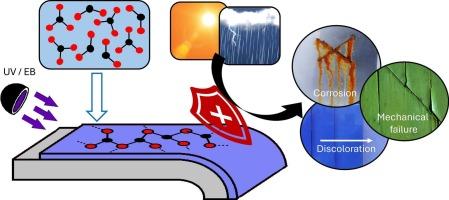Outdoor durability of radiation-cured coatings – A review
IF 7.3
2区 材料科学
Q1 CHEMISTRY, APPLIED
引用次数: 0
Abstract
Radiation cure coatings are increasingly popular in scientific and industrial communities, due to potential savings in energy and environmental footprint: UV or electron beam (EB) cured coatings can be formulated without water or organic solvent, which allows curing with a fraction of the time and energy required for conventional alternatives. However, compared to other coating types, much less studies have investigated their outdoor durability, crucial to protect the exterior of buildings, vehicles or industrial structures. This review gathers these efforts to understand and improve the outdoor durability of exterior UV/EB coatings. A general description of photodegradation of conventional and radiation-cured polymers is presented, followed by an overview of studies on effects of formulation, cure and mechanical properties, as well as studies on corrosion protection.
Several crucial concepts were shown in past studies, such as the effect of molecular structures on photostability, or heat- or UV-induced mechanical aging. However, the field still lacks studies encompassing a broader range of parameters, for example not only focusing on molecular mechanisms of photodegradation, but also wider film properties, such as Tg, permeability to water and oxygen, or the effect of pigments. Because of the extensive use of similar aliphatic polyurethane acrylates, limited information can be found on other chemistries. Finally, real outdoor durability results, despite their long running time, are necessary to confirm studies mostly done with accelerated methods.

辐射固化涂料室外耐久性研究进展
辐射固化涂料在科学和工业领域越来越受欢迎,因为它可以节省能源和环境足迹:UV或电子束(EB)固化涂料可以在没有水或有机溶剂的情况下配制,这使得固化所需的时间和能量仅为传统替代品所需的一小部分。然而,与其他涂层类型相比,对其户外耐久性的研究要少得多,而户外耐久性对于保护建筑物、车辆或工业结构的外部至关重要。本文综述了这些研究成果,旨在了解和提高UV/EB涂料的户外耐久性。介绍了常规聚合物和辐射固化聚合物的光降解的一般情况,然后概述了配方、固化和机械性能的影响以及腐蚀防护的研究。过去的研究显示了几个关键的概念,如分子结构对光稳定性的影响,或热或紫外线诱导的机械老化。然而,该领域仍然缺乏涵盖更广泛参数的研究,例如不仅关注光降解的分子机制,而且还关注更广泛的薄膜性质,如Tg,对水和氧的渗透性,或颜料的影响。由于广泛使用类似的脂肪族聚氨酯丙烯酸酯,有限的信息可以找到其他化学品。最后,真实的户外耐久性结果,尽管他们的运行时间很长,是必要的,以确认研究大多是用加速方法完成的。
本文章由计算机程序翻译,如有差异,请以英文原文为准。
求助全文
约1分钟内获得全文
求助全文
来源期刊

Progress in Organic Coatings
工程技术-材料科学:膜
CiteScore
11.40
自引率
15.20%
发文量
577
审稿时长
48 days
期刊介绍:
The aim of this international journal is to analyse and publicise the progress and current state of knowledge in the field of organic coatings and related materials. The Editors and the Editorial Board members will solicit both review and research papers from academic and industrial scientists who are actively engaged in research and development or, in the case of review papers, have extensive experience in the subject to be reviewed. Unsolicited manuscripts will be accepted if they meet the journal''s requirements. The journal publishes papers dealing with such subjects as:
• Chemical, physical and technological properties of organic coatings and related materials
• Problems and methods of preparation, manufacture and application of these materials
• Performance, testing and analysis.
 求助内容:
求助内容: 应助结果提醒方式:
应助结果提醒方式:


